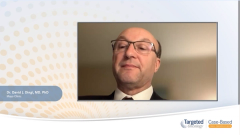
Talquetamab and Elranatamab: Bispecific Antibodies in Relapsed/Refractory Multiple Myeloma
Insights into the use of bispecific antibodies, including talquetamab, and elranatamab, in treating relapsed/refractory multiple myeloma, discussing their efficacy and potential side effects.
Episodes in this series

Transcript:
David M. Dingli, MD, PhD: We’ve been fortunate the past year where we have 3 bispecific antibodies that have been approved for relapsed/refractory multiple myeloma. We already talked about teclistamab. The second antibody that was introduced was talquetamab, [which] targets GPRC5D, and this bispecific [antibody] was studied in the MonumenTAL study in patients with relapsed/refractory disease. Patients also essentially had pentarefractory disease and they could or could not have been treated with a BCMA [B-cell maturation antigen]–targeted agent. Patients again received step-up dosing with this agent, and the main outcome measure was again overall response rate, together with PFS [progression-free survival] and the quality of the responses; the number of patients who achieved CR [complete response] or VGPR [very good partial response]…sCR [stringent complete response], patients who achieved MRD [minimal residual disease] negativity, and, of course, safety.
Now, GPRC5D is not restricted to the multiple myeloma cells. It can be expressed in the skin, also expressed in the gastrointestinal tract, and that explains some of the potential toxicities related to this agent. Importantly, GPRC5D provides a different target compared with BCMA, and there are several potential differences, therefore, with respect to the safety and toxicity of these agents and how they should be positioned in the care of the patient [with relapsed disease].
So, to go back for a minute…with the BCMA-targeted agents, we are expecting, and in fact this has been well observed, to have some immunosuppression related to the hypogammaglobulinemia and some T-cell exhaustion that can occur with prolonged therapy with the BCMA-targeted bispecific [antibodies]. In the case of talquetamab, the immunosuppression is presumably less because, yes, we can tax the T cells, but we are not inducing B-cell aplasia. So the data show that the risk of infections with talquetamab actually is at least numerically less than what one would expect with teclistamab.
However, talquetamab is associated with its own [toxicities]—in particular dysgeusia, skin changes, nail changes—that often are grade 1 or 2 and improve over time. The response rate in MonumenTAL was approximately 72%. Many patients achieved CR, approximately 35% of patients achieved sCR, and 58% of patients had the VGPR or better response. And the duration of response is, again, north of a year. The advantage, of course, of having a different target is that now patients treated with a BCMA-targeted agent could proceed. If once they progress and when they progress, they can be treated with a different bispecific antibody that has a separate target. And indeed, now we have data that show that this strategy works. The patients who have been exposed and progress after a BCMA-targeted agent have had a high rate of response to talquetamab. So another important arrow in our quiver treating multiple myeloma.
The other drug that we need to address today is elranatamab, which is another BCMA-targeted bispecific antibody that was also recently approved. The drug works essentially similar to the other 2 bispecific antibodies. It binds to plasma cells via BCMA as in teclistamab and engages T cells. So the mechanism of action is similar. So as expected, the [adverse] effect profile would be similar with respect to cytopenias, risk of infections, etc.
The response rate in the MagnetisMM-3 trial [NCT04649359] was in the range of 60%. And in MagnetisMM-3 there was also an important subset of patients who had prior BCMA exposure. And that could include either a prior BCMA-targeted bispecific [antibody] or a CAR T cell or even an antibody-drug conjugate such as belantamab. And again, here we see efficacy in patients with prior exposure to BCMA-targeted agents, and in particular the response rates are very respectable, 50%-plus. So the patient who has been exposed to a BCMA-targeted agent in the past could potentially be treated with another BCMA-targeted agent. The toxicity reported in the MagnetisMM-3 study is similar to what has been reported with teclistamab.
Both drugs are given as a step-up dosing, and the label requires hospitalization for the first 2 or 3 doses because of the risk of cytokine release syndrome and neurotoxicity, and the patients may require steroids as well as teclistamab to treat the cytokine release syndrome. But as I mentioned, it’s important to put this in perspective because the risk is not universal, and many patients will not develop significant cytokine release syndrome, and even if they develop cytokine release syndrome, it tends to be rather short-lived.
Transcript is AI-generated and edited for readability.





































